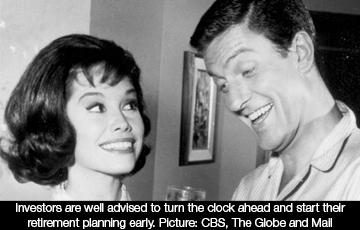
Special to the Globe and Mail
Published February 26, 2015
By Tom Bradley
My favourite scene from The Dick Van Dyke Show was one where Laura (Mary Tyler Moore) tricks Rob into getting out of bed by turning the clock ahead. I know I’m dating myself, but I reference this sketch for a reason. Like Laura, I want investors to turn the clock ahead. Let me explain.
Intense interest
As we grow our business and work with more Canadians, I’ve observed a distinct trend – people get really engaged in investing and their portfolio in their 50s. There’s a noticeable change in intensity as they advance through this decade.
There are a number of things that trigger this increased interest. As their nests empty, the fiftysomethings have more time and discretionary income. Sometimes a market event may get their attention or (happily) their portfolios get too big to ignore. But the biggest reason for the engagement of those in their 50s with their financial well-being is that retirement comes clearly into view. Suddenly it’s only one family reunion, two new cellphones and three diets away, and this realization brings with it a new sense of urgency.
What happens at this stage is all positive. Fiftysomethings read their statements more carefully and are more pro-active in dealing with issues that have been left unresolved for years – money sitting in a savings account; a poor adviser relationship; or RRSPs and TFSAs spread across four or five firms.
Investors in their 50s also ask more questions. How have I been doing? What am I actually paying to have my money managed? Does my portfolio match up with my pension? How much do I need to retire?
By getting answers to these questions and dealing with lingering issues, this cohort is more likely to experience higher returns going forward.
Turn the clock ahead
As to the Dick Van Dyke reference, it would be even better if investors started reaping these rewards sooner by getting engaged in their retirement plan in their 40s.
You might ask, why not even earlier? Isn’t it proven that if people start investing at a young age, they’ll be set for life? Well of course, the earlier the better, but I’m trying to be realistic. It’s a big ask as it is, and younger investors have limited funds to invest due to the demands of raising children and buying a house in an expensive market.
Fortysomethings have financial challenges too, but if their goal is to retirement at 65 or earlier, then they’re going to need 20 years of healthy contributions and a properly structured portfolio to get there.
No downside
In an industry where there are no sure things, the benefits of picking up the intensity sooner are undeniable. It was Albert Einstein who declared the power of compounding to be the eighth wonder of the world. People in their 40s may regret not having started in their 20s, but the math related to getting started earlier is still compelling – a dollar invested today can double twice in two decades.
Focused fortysomethings also have a better chance of investing smarter, even if they can’t contribute more initially.
-
They’ll develop a better savings discipline.
- With retirement not yet in sight, they’ll be more comfortable with a growth-oriented asset mix that befits their extended time horizon.
- They’ll catch on sooner to the fact that their asset mix should take into account all their financial assets, including any pension plans.
- They won’t have any lazy money sitting around doing nothing.
- They’ll get their fees under control and stop paying for services they’re not receiving.
- And importantly, they won’t put off the hard decisions about the person and investment firm they’re dealing with. For investors who are on top of their portfolio, saying “My adviser is a nice person” is not a good enough reason to stay in an unsatisfactory relationship.
If you’re in your 40s, I encourage you to talk to your “ancient” friends and family members. Try to channel their new-found intensity toward investing. And then one-up them by turning up the dial before you hit the big five-oh.

